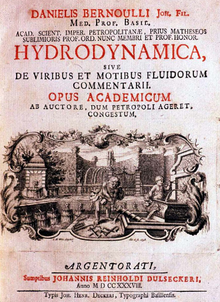This article has multiple issues. Please help improve it or discuss these issues on the talk page. (Learn how and when to remove these messages)
|

Hydrodynamica (Latin for Hydrodynamics) is a book published by Daniel Bernoulli in 1738.[1][2] The title of this book eventually christened the field of fluid mechanics as hydrodynamics.
Contents
The book deals with fluid mechanics and is organized around the idea of conservation of energy, as received from Christiaan Huygens's formulation of this principle. The book describes the theory of water flowing through a tube and of water flowing from a hole in a container. In doing so, Bernoulli explained the nature of hydrodynamic pressure and discovered the role of loss of vis viva in fluid flow, which would later be known as the Bernoulli principle. The book also discusses hydraulic machines and introduces the notion of work and efficiency of a machine. In the tenth chapter, Bernoulli discussed the first model of the kinetic theory of gases. Assuming that heat increases the velocity of the gas particles, he demonstrated that the pressure of air is proportional to kinetic energy of gas particles, thus making the temperature of gas proportional to this kinetic energy as well.[1]
-
A 1738 copy of Hydrodynamica
-
First page of the first section of Hydrodynamica, 1738
Notes
- ^ a b Mikhailov 2005, pp. 131–42
- ^ The book's full title is Hydrodynamica, sive de Viribus et Motibus Fluidorum Commentarii (Hydrodynamics, or commentaries on the forces and motions of fluids)
Bibliography
- Mikhailov, G.K. (2005). "Hydrodynamica". In Grattan-Guinness, Ivor (ed.). Landmark Writings in Western Mathematics 1640–1940. Elsevier. pp. 131–42. ISBN 978-0-08-045744-4.
- Bernoulli, Daniel (1738). Hydrodynamica, sive de viribus et motibus fluidorum commentarii (in Latin, source ETH-Bibliothek Zürich, Rar 5503). sumptibus Johannis Reinholdi Dulseckeri; Typis Joh. Deckeri, typographi Basiliensis. doi:10.3931/e-rara-3911.










